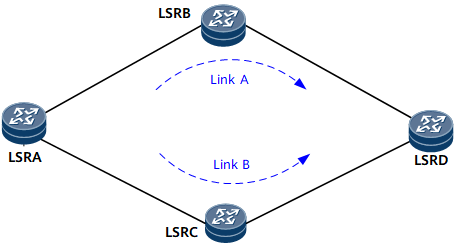Association Between LDP and Static Routes
Background
On a network with a backup path between label switching routers (LSRs), packet loss may occur during a traffic switchover or switchback because the status of a static route is different from that of a Label Distribution Protocol (LDP) session. To resolve this problem, configure association between LDP and static routes.
Typical Networking
Figure 1 shows the typical networking of association between LDP and static routes. LSRA and LSRD interwork through static routes. Primary and backup static routes are deployed on LSRA, with the next-hop devices being LSRB and LSRC, respectively. Primary and backup LDP LSPs are established based on the static routes. The primary LSP uses Link A, and the backup LSP uses Link B. In normal cases, Link A is preferred. Association between LDP and static routes in switchover and switchback scenarios is described as follows.

Switchover scenario
In the switchover scenario, traffic of the primary static route is not switched to the backup link when the LDP session on the primary link fails (not because of a link fault). As a result, traffic on the LSP over the primary link is interrupted.
After an LDP session is established, LSP traffic travels along the primary link, Link A (LSRA → LSRB → LSRD). If the LDP session between LSRA and LSRB is interrupted, traffic of the primary LSP is switched immediately to the backup link, Link B (LSRA → LSRC → LSRD). However, because the link between LSRA and LSRB is normal, traffic of the primary static route is not switched to the backup link. The asynchronous state between LDP and the primary static route causes an LSP traffic interruption.
If association between LDP and static routes is enabled, traffic is automatically switched to the backup link when the LDP session goes Down, ensuring uninterrupted traffic forwarding.
Switchback scenario
In the switchback scenario, when the primary link recovers from a fault, the traffic of the primary static route is switched back to Link A earlier than the traffic of the primary LSP because the convergence of static routes is faster than that of LDP LSPs. As a result, the backup LSP on Link B cannot be used, and the LSP on Link A has not been set up yet. As a result, LSP traffic is interrupted.
If the link between LSRA and LSRB fails, traffic is switched immediately to the backup link, Link B (LSRA → LSRC → LSRD). After the link between LSRA and LSRB recovers, traffic of the primary static route is immediately switched back to Link A (LSRA → LSRB → LSRD). However, the backup LSP cannot be used, and the LSP on Link A has not recovered yet. As a result, traffic is interrupted.
If association between LDP and static routes is enabled, the static route on Link A becomes active only when the LDP session on Link A goes Up. In this manner, the states of the primary static route and LSP are asynchronous during the switchback, which prevents traffic loss.
Usage Scenario
Association between LDP and static routes applies to scenarios where a static route backup path exists between LSRs.
Benefits
Association between LDP and static routes ensures state consistency between LDP and static routes, prevents traffic loss, and improves network reliability.